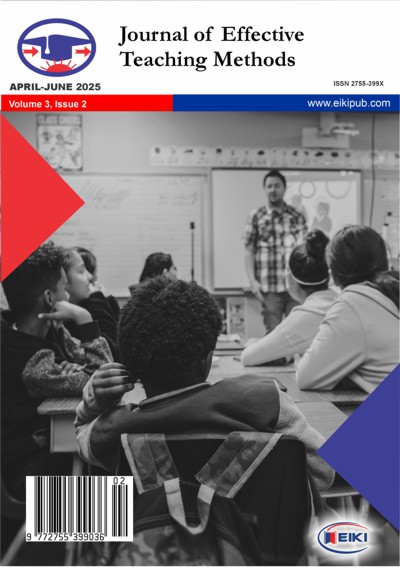Utilization Of Videocast In Enhancing Audio-Visual Learning Skill Of Grade 7 Students
Main Article Content
Abstract
This study investigates the enhancement of audio-visual learning skills among twelve Grade 7 students at Santa Cruz Integrated National High School (Main) through researcher-developed videocasts. Utilizing an explanatory mixed-methods design, the research integrates quantitative data from pre-tests and post-tests, followed by qualitative data to thoroughly assess student outcomes. A case study framework is employed to evaluate learning progress, while a quasi-experimental design measures the effects of a two-week intervention. The researchers selected the 12 participants through purposive sampling from a sample of 41 students across two sections. Initial pre-test results revealed that students using audio-visual methods exhibited "fair" to "satisfactory" learning skills. However, following the intervention, post-test scores demonstrated significant improvement, with students achieving "very satisfactory" to "excellent" levels. A t-test was performed to analyze the differences between pre-test and post-test performance, confirming that these improvements were statistically significant. Additionally, a one-way ANOVA analysis indicated that variations in learning styles did not significantly impact post-test outcomes. Collectively, these findings suggest that the integration of videocasts substantially enhanced the audio-visual learning skills of the students.
Metrics
Article Details

This work is licensed under a Creative Commons Attribution 4.0 International License.
References
Ambubuyog, E. M. I., Laumoc, G. L. C., Mantac, F. H. A., Pagulayan, F. M. C., Sayson, C. J. E. C., Velasco, A. C. M., & Biray, E. T. (2023). Active Listening: Its Impact on Language Learning and Understanding of Education Students. International Journal of Multidisciplinary: Applied Business and Education Research, 4(2), 671–676. https://doi.org/10.11594/ijmaber.04.02.33 DOI: https://doi.org/10.11594/ijmaber.04.02.33
Ashikuzzaman, MD. (2024). The Role of Audio-Visual Aids in Education. Library & Information Science Education Network. Library & Information Science Education Network. https://www.lisedunetwork.com/the-role-of-audio-visual-aids-in-education/
Averion, R. F., Caleja, H. B. F., & Zapanta, V. M. (2020). LED TV in the classroom: it’s acceptability and effectiveness in the Philippines. PUPIL: International Journal of Teaching, Education and Learning, 4(2), 33–56. https://doi.org/10.20319/pijtel.2020.42.3356 DOI: https://doi.org/10.20319/pijtel.2020.42.3356
Bacia, M. K. (2024). Role of Instructional Materials in Students’ Academic Performance. Research invention journal of current research in humanities and social sciences, 3(2), 24-27.
Best, E., & Clark, C. (2021). The role of audiobooks to engage reluctant readers and underrepresented children and young people: A National Literacy Trust research report. London: National Literacy Trust.
Catalyst Learning Curricula. (2024). Student-centered lesson plans and specialized training for teachers. https://catalystlearningcurricula.com
Cevher, A. Y., & Yildirim, S. (2020). Investigation of Academic Studies on Learning Styles: A Systematic Review. Hayef: Journal of Education, 17(1), 20–50. https://doi.org/10.5152/hayef.2020.1922 DOI: https://doi.org/10.5152/hayef.2020.1922
Henebery, B. (2022, May 23). How to supercharge your school’s video learning in 2022. The Educator Australia. https://www.theeducatoronline.com/k12/news/how-to-supercharge-your-schools-video-learning-in-2022/280173
Joblon, J. (2023). Breaking Barriers to Literacy: Using Audiobooks to Overcome Reading Challenges. EdSurge. https://www.edsurge.com/news/2023-03-20-breaking-barriers-to-literacy-using-audiobooks-to-overcome-reading-challenges
Kathirvel, K., & Hashim, H. (2020). The Use of Audio-Visual Materials as Strategies to Enhance Speaking Skills among ESL Young Learners. Creative Education, 11, 2599-2608. DOI: 10.4236/ce.2020.1112192 DOI: https://doi.org/10.4236/ce.2020.1112192
Letourneau, S. M., & Sobel, D. M. (2020). Children’s descriptions of playing and learning as related processes. PLoS ONE, 15(4), e0230588. https://doi.org/10.1371/journal.pone.0230588 DOI: https://doi.org/10.1371/journal.pone.0230588
Muppalla, S. K., Vuppalapati, S., Reddy Pulliahgaru, A., & Sreenivasulu, H. (2023). Effects of Excessive Screen Time on Child Devel-opment: An Updated Review and Strategies for Management. Cureus, 15(6), e40608. https://doi.org/10.7759/cureus.40608 DOI: https://doi.org/10.7759/cureus.40608
Privado, N. R., & Hermosa, J. F. (2023). Audio –Visual Input for Improving the Cognitive Skills of Grade 10 Students in Araling Pan-lipunan. International Journal of Multidisciplinary: Applied Business and Education Research, 4(5), 1632-1637. https://doi.org/10.11594/ijmaber.04.05.24 DOI: https://doi.org/10.11594/ijmaber.04.05.24
Reading Rockets. (2025). Classroom Strategies: Visual Imagery. https://www.readingrockets.org/classroom/classroom-strategies/visual-imagery?__cf_chl_rt_tk=01oF_tvv1e0rnD4HDCyb82z9A3DFzcBORssxQf4zUBo-1717485444-0.0.1.1-3881
Santos, N., & Paglinawan, R. (2023). Curriculum and classroom challenges in teaching viewing comprehension skills to high school students. Asian Journal of English Language Studies, 11, 117–132. https://doi.org/10.59960/11.a5 DOI: https://doi.org/10.59960/11.a5
Saunders, M.N.K., Lewis, P., & Thornhill, A. (2019). Research Methods for Business Students, 8th Edition. New York: Pearson.
Singh, H. (2022). Teaching Modeling. Harappa. https://harappa.education/harappa-diaries/modeling-in-teaching
Suing, A., Arrobo-Agila, J.-P., Coronado-Otavalo, X., Galarza-Ligña, V., & Reascos-Trujillo, A. (2023). Audiovisual Competences in Times of COVID-19: The Role of Educational Actors in Media and Digital Learning of Adolescents. Sustainability, 15(7), 6323. https://doi.org/10.3390/su15076323 DOI: https://doi.org/10.3390/su15076323
Swargiary, K., & Roy, K. (2023). The Impact of Study Environment on Students’ Academic Performance: An Experimental Research Study. Qeios. https://doi.org/10.32388/J7B6RG.2 DOI: https://doi.org/10.32388/J7B6RG.2
Syahabuddin, K., & Rizqa, K. (2021). Improving students’ listening skills using podcasts. Journal of Digital Education, Communications, and Arts, 4(1), 51–61. https://doi.org/10.30871/deca.v4i01.2867 DOI: https://doi.org/10.30871/deca.v4i01.2867
Tobin, S. J., & Guadagno, R. E. (2022). Why people listen: Motivations and outcomes of podcast listening. PLoS ONE, 17(4), e0265806. https://doi.org/10.1371/journal.pone.0265806 DOI: https://doi.org/10.1371/journal.pone.0265806
Ünal, K. (2022). A Study on the Effect of Visual and Auditory Tools in Foreign Language Teaching. Journal of Research in Social Sciences and Language, 2(2),108-117. https://doi.org/10.20375/0000-000f-7453-1
Wahyuni, R., & Nissa, K. (2023). The Impact of Using Audio Visual Media on Students’ Learning Outcomes in English Grade VII of Junior High School. English Teaching and Linguistics Journal, 4(2), 102-115. DOI: https://doi.org/10.30596/etlij.v4i2.16067
Wang, Z., & Shao, Y. (2024). Picture book reading improves children’s learning understanding. British Journal of Development Psychology, 43(1), 12-35. https://doi.org/10.1111/bjdp.12479 DOI: https://doi.org/10.1111/bjdp.12479

